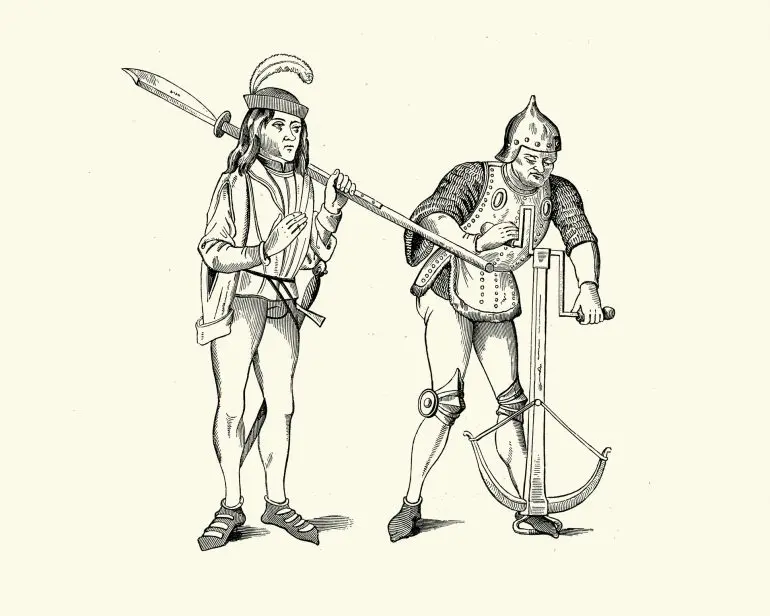Distinct for its single-edged blade, the glave – interchangeably spelled glaive – was in many ways the ultimate medieval battlefield weapon. Agile, easy to wield, and capable of devastatingly accurate cutting and thrusting blows against man and animal, this iconic medieval pole weapon was described in the sixteenth century as one of the most effective hand-to-hand combat weapons ever created.
This is the fascinating story of the glave, a potent symbol of medieval battlefield might.
What is a Glave?

Examples of the medieval glave (Credit: duncan1890 via Getty Images)
A glaive is a type of polearm, commonly described as a weapon with a handle long enough to make it stand as tall, or even taller, than the soldier wielding it.
Typically measuring around two metres in length, the glaive traditionally featured a single-edged blade fixed to the end of a long wooden pole. The blade itself, usually between 45 to 60 centimetres long, was reminiscent of a knife or sword, making the glave, similar to other medieval polearms, a hybrid weapon capable of both cutting, slicing and thrusting. Weighing approximately two kilograms, the balanced construction allowed cavalry and infantrymen to wield it with both precision and power, targeting vulnerable points in enemy armour and earning the weapon a respected – and feared – place in the theatre of war.
The History of the Famous Medieval Pole Weapon

15th century knights with fauchard and halberd polearms (Credit: duncan1890 via Getty Images)
Similar to the war scythe, fauchard, and other medieval polearms, the genesis of the glave can most likely be traced back to modified spears and agricultural tools. There doesn’t appear to be a single point of creation – almost everyone in Europe, from the Welsh to the Hugarians have claimed its invention – and it seems as if they were used as early as the twelfth century up to and around the fifteenth.
As with almost all weapons, the glave evolved over the centuries alongside advances in blade technology and manufacturing techniques, as well as upgraded designs and regional variations. And the concept of the medieval pole weapon wasn’t restricted to Europe. They were developed independently all over the world, including some of the most famous, and lethal, medieval polearms such as the Chinese guandao, the Japanese naginata, the Korean woldo, and the Russian sovnya.
While the glave, or its predecessors, were being used in the twelfth or thirteenth century to some degree, from around the fourteenth century it increasingly became a staple in the arsenals of various European armies, reflecting the evolving tactics and technologies of medieval warfare.
The Glaive-Guisarme

Sixteenth century glaive polearms (Credit: powerofforever via Getty Images)
One early variation was known as the glaive-guisarme. Probably from the Old High German getīsarn meaning ‘weeding iron’, this version included the addition of a hook or reverse spike on the back of the blade.
The primary difference between the standard glave and this hook pole weapon lies in the latter’s extended capability for grappling and hooking actions. While the glaive was primarily designed for slashing and thrusting, the glaive-guisarme featured a secondary, hook-like blade or spike on the opposite side of the main blade. This addition allowed soldiers to pull mounted knights from their horses, trip foot soldiers, and manipulate or disarm opponents. The hook could also be used to breach fortifications or drag down shields, adding a layer of tactical flexibility not found in the standard weapon.
This adaptation into a hook pole weapon made the glaive-guisarme particularly effective in the close-quarters combat typical of medieval warfare, where versatility and adaptability were crucial.
The Decline of the Glaive

Tower of London 'Beefeaters' with polearms (Credit: duncan1890 via Getty Images)
The famed medieval pole weapon remained popular for several centuries, however, as firearms and more sophisticated armour and advanced melee weapons became prevalent in the sixteenth century, the popularity of the glave began to wane.
As the Middle Ages gave way to the Renaissance and beyond, the glaive was no match for the latest, plate-armoured knights, and as gunpowder-based weapons began to emerge, medieval polearms of all types were rendered obsolete, transitioning into nothing more than highly decorated ceremonial weapons. The halberd, for example, is carried by the Pontifical Swiss Guard, the armed force protecting HH The Pope, as well as the Yeoman of the Guard, better known as Beefeaters, who are the ceremonial guardians of the Tower of London.
Ceremonial polearms are also carried by the Portuguese National Republican Guard, the French Republican Guard, and the Spanish Royal Guard.
The Enduring Legacy of the Glave Polearm

Medieval soldier with a glaive (Credit: duncan1890 via Getty Images)
The glaive polearm, with its unique blend of reach, power, and versatility, is indeed a medieval icon. From its humble origins, its evolution into a brutal weapon, and its eventual decline in favour of firearms, the glaive remains a symbol of the medieval battlefield.










